
Consumer Insights
Uncover trends and behaviors shaping consumer choices today
Procurement Insights
Optimize your sourcing strategy with key market data
Industry Stats
Stay ahead with the latest trends and market analysis.
Trending Now


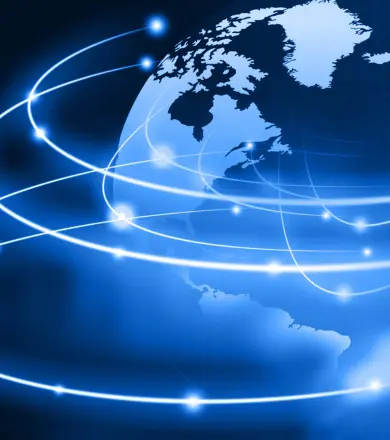
The global cryogenic equipment market value reached around USD 12.97 Billion in 2024 due to use of cryogenic equipment in many industrial applications. The growing emphasis on industrial gases for applications in healthcare, food processing, and electronics further contributes to market expansion. As a result, the industry is expected to grow at a CAGR of 6.70% during the forecast period of 2025-2034 to attain a value of USD 24.81 Billion by 2034. The increasing demand for liquefied natural gas (LNG) as a cleaner energy source significantly boosts the need for cryogenic equipment, particularly in energy and power sectors of North America, Europe, and Asia.
Base Year
Historical Year
Forecast Year






Value in USD Billion
2025-2034
Cryogenic Equipment Market Outlook
*this image is indicative*
| Global Cryogenic Equipment Market Report Summary | Description | Value |
| Base Year | USD Billion | 2024 |
| Historical Period | USD Billion | 2018-2024 |
| Forecast Period | USD Billion | 2025-2034 |
| Market Size 2024 | USD Billion | 12.97 |
| Market Size 2034 | USD Billion | 24.81 |
| CAGR 2018-2024 | Percentage | XX% |
| CAGR 2025-2034 | Percentage | 6.70% |
| CAGR 2025-2034 - Market by Region | Asia Pacific | 8.4% |
| CAGR 2025-2034 - Market by Country | India | 9.7% |
| CAGR 2025-2034 - Market by Country | China | 8.1% |
| CAGR 2025-2034 - Market by Equipment | Tanks | 8.2% |
| CAGR 2025-2034 - Market by End User | Energy and Power | 8.3% |
| Market Share by Country 2024 | Germany | 4.6% |
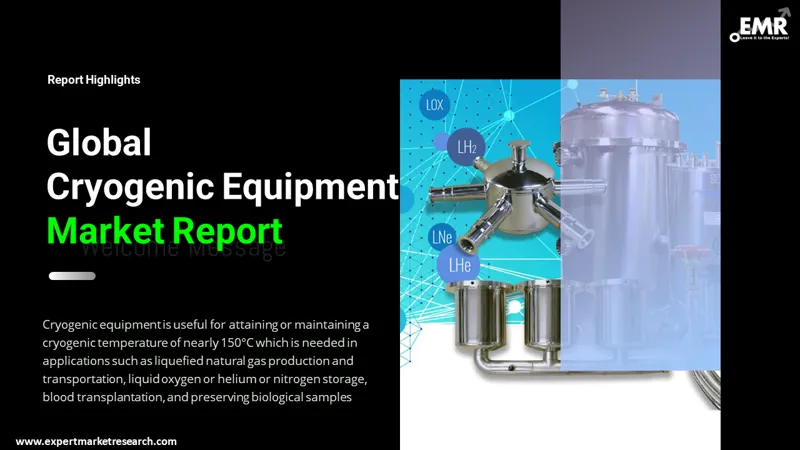
Read more about this report - REQUEST FREE SAMPLE COPY IN PDF
Cryogenic equipment produces or is employed in the production of very low temperature materials or processes. Cryogenics involves temperatures colder than those that can be attained with conventional refrigeration equipment. Cryogenic equipment is devised to touch very-low temperatures at a slow rate to prevent thermal shock to the components being treated. Cryogenic temperatures range from -238 °F (-150° C, 123.2 K°) to absolute zero. Cryogenic equipment is needed in applications such as liquefied natural gas production and transportation, liquid oxygen or helium or nitrogen storage, blood transplantation, and preserving biological samples.
At such low temperatures, substances that are naturally gases can be liquefied; some metals lose electrical resistance, as they get colder, which can impact the cryogenic equipment market dynamics and trends. Cryogenic equipment includes cryogenic refrigerators, temperature controllers, cryogenic storage racks and boxes, cryogenics accessories and cryogenic tanks. A cryogenic tank or dewar is employed to store cryogenic gases such as liquid oxygen, nitrogen, argon, carbon dioxide, and methane in bulk quantities. Cryogenic refrigerators are employed to preserve cryogenic materials. In a cryogenic refrigerator, a refrigerant is circulated in a fluid flow path between the first and second chambers by the movement of a displacer.
Growing demand for LNG, technological innovations, and rising use in medical and industrial applications are the key trends propelling the market growth.
Growing demand for LNG, especially in Asia, is expected to boost market growth. In 2021, the USA led export growth with a year-on-year increase of over 23 million mt. In 2021, China and South Korea led the growth in LNG demand. Global LNG demand is expected to increase significantly soon. Asia is expected to be a key driver of the growth of the cryogenic equipment market. Leading companies offer LNG cryogenic equipment. For example, Technifab offers vacuum jacketed hoses and piping for use in a variety of LNG applications; the company’s vacuum jacketed pipe decreases liquid loss with LNG and can offer quicker liquid delivery time to the end use point. The company also manufactures our own line of vacuum-insulated valves. Tehchnifab also helps other firms develop custom cryogenic equipment, including dewars, that are used for LNG.
Technological innovations including improvements in insulation materials and safety features, are enhancing the efficiency of cryogenic equipment and adding to the cryogenic equipment market value. These advancements are crucial for applications in sectors such as healthcare, metallurgy, and electronics. In January 2021, Fives was awarded a contract to supply 13 Cryomec cryogenic centrifugal pumps for a new Air Separation Unit (ASU) in China. This ASU will have an oxygen production capacity of over 2,000 tons per day and is being built in the Lingang Economic District, Tianjin Port Free Trade Zone. In metallurgy, cryogenic equipment is essential for processes like cryogenic hardening, which improves the mechanical properties of metals by treating them at extremely low temperatures. This results in enhanced durability and performance of materials used in various applications, including automotive and aerospace industries. Companies like CTP Cryogenics utilise cryogenic hardening to improve the strength and durability of aerospace components.
Cryogenic equipment is employed in multiple applications. Examples include storage and transportation of liquefied gases, food preservation, cryosurgery, rocket fuels, and super-conducting electromagnets. Cryogenic liquids have medical and industrial applications; liquid nitrogen is used to conduct chemical reactions that warrant low temperatures; liquid hydrogen and oxygen are used as fuels for rockets. Small vacuum flasks and dewar flasks are used for storing liquefied gases; for larger industrial operations, large cryogenic storage tanks are used which can contribute to the cryogenic equipment market revenue. Materials are transferred from carriers to cryogenic containers or cryo tanks with the help of cryogenic transfer pumps. Cryogenic-refrigerators and freezers are used to fast freeze vaccines and preserve biological samples (for example human blood, embryos and tissue). Such applications are expected to boost the global cryogenic equipment market. Leading companies offer sophisticated solutions for multiple industries for example, Cryofab offers cryogenic products for several industries, including medical, biotechnology, research, instrumentation, semi-conductor, superconductivity, home care and food service.
Regions such as Asia-Pacific are experiencing dynamic growth due to rapid industrialisation and increasing energy demands. Countries like China and India are investing in LNG infrastructure, further boosting the cryogenic equipment market. In 2024, the primary energy demand in Asia-Pacific is projected to reach approximately 328 quadrillion British thermal units (BTUs) by 2050, with natural gas demand rising from about 36 quadrillion BTUs in 2025 to 56 quadrillion BTUs by 2050. This shift is crucial as countries look to transition from coal and oil to cleaner energy sources. China is expected to lead this transition due to USD 360 billion investment in renewable power in 2024. Meanwhile, Southeast Asia's investment in renewable energy is projected at USD 15 billion. The region's commitment to LNG as a cleaner energy source is evident as it seeks to reduce greenhouse gas emissions and enhance energy security. As industrialisation continue, countries like India are also anticipated to see the large growth in energy demand globally, further driving the need for advanced cryogenic equipment essential for LNG production and storage.
Nitrofreeze offers cryogenic treatment services specifically for motorsports and automotive parts. Their treatment enhances the performance of engine components, transmissions, and brake rotors by reducing fatigue failures and improving wear resistance. As per the cryogenic equipment industry analysis, this results in longer-lasting parts that can withstand the rigours of high-performance racing.
Aalberts ST specialises in deep cryogenic treatment to transform unstable austenite into a martensitic structure in steel components. This process not only improves strength but also enhances dimensional stability and reduces residual stresses, making it beneficial for various industrial applications. Moreover, voestalpine provides cryogenic treatment for tool steel, achieving ultra-low temperatures of around -196°C to remove retained austenite from quenched tools. This process increases wear resistance and overall durability, making tools more effective for cutting and machining applications.
Manufacturing cryogenic equipment requires premium materials such as stainless steel and specialised alloys that can withstand extremely low temperatures. These materials are expensive, leading to high capital expenditure (CAPEX) and operational expenditure (OPEX), which can deter investment, particularly from small and medium enterprises, affecting the cryogenic equipment demand. The prices of raw materials used in cryogenic equipment production can be volatile and influenced by global market trends. Fluctuating costs can affect profitability and create uncertainty for manufacturers, making it challenging to maintain competitive pricing.
Handling ultra-cold substances such as liquefied natural gas (LNG), liquid nitrogen, and oxygen presents technical challenges. Precision engineering is required to prevent leaks, ensure proper insulation, and maintain safety during operation. These complexities can increase the risk of operational failures and necessitate ongoing maintenance, further driving up costs.
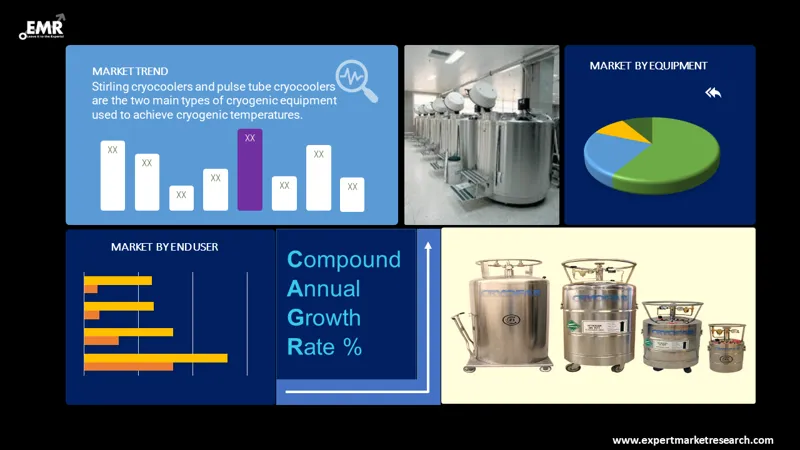
Read more about this report - REQUEST FREE SAMPLE COPY IN PDF
“Cryogenic Equipment Market Report and Forecast 2025-2034” offers a detailed analysis of the market based on the following segments:
Market Breakup by Equipment
Market Breakup by Cryogen
Market Breakup by End User
Market Breakup by Region
Market Insights by Equipment
The tank segment holds the highest cryogenic equipment market share. This is primarily due to the extensive applications of cryogenic tanks in various industries, particularly for the storage and transportation of liquefied natural gas (LNG) and other cryogenic fluids. The demand for LNG as a cleaner energy source has significantly boosted the need for efficient storage solutions, making tanks a critical component of the market.
Pumps are also essential for transferring cryogenic fluids, ensuring efficient movement within systems, particularly in applications that require precise control of liquid flow, such as liquefied natural gas (LNG) processing and storage. Valves serve to regulate the flow of cryogenic fluids, providing safety and control across various applications. They are vital for preventing leaks and maintaining pressure in cryogenic systems, making them indispensable in industries like energy and healthcare. Vaporizers, on the other hand, convert cryogenic liquids into gases, facilitating their use in numerous applications. This equipment is particularly important for LNG operations, where efficient gasification is crucial for energy production and distribution.
Market Insights by Cryogen
Cryogenic equipment such as cryocoolers and liquid nitrogen equipment are used to achieve cryogenic temperatures. There are two main types of crycoolers: stirling cryocooler and pulse tube cryocooler. Cryogenic equipment that employs liquid nitrogen gas as a coolant is called liquid nitrogen equipment. Liquefied nitrogen gas, owing to its high density in a liquid state, is capable of being easily stored, safely transported, and employed as a coolant, boosting cryogenic equipment market opportunities. Liquid nitrogen refrigerators offer low daily evaporation losses. Crycoolers and liquid nitrogen equipment can be regulated by computers.
Argon is also widely used in industrial applications such as metal fabrication and electronics manufacturing due to its inert properties, which make it an ideal shielding gas. LNG is another dominant segment in the market, driven by the increasing demand for cleaner energy sources. The growth of LNG is supported by expanding infrastructure and applications across various industries.
Market Insights by End User
The energy and power sector holds the highest cryogenic equipment market share. This dominance is largely attributed to the increasing demand for liquefied natural gas (LNG) as a cleaner energy source, which necessitates efficient storage and transportation solutions provided by cryogenic equipment. The growing emphasis on sustainable energy practices and the expansion of LNG infrastructure globally are driving significant investments in this sector.
The electronics sector is also experiencing rapid growth as it uses cryogenic cooling solutions for applications such as superconducting materials and quantum computing. Additionally, the shipping industry relies on cryogenic equipment for the safe transport of liquefied gases, ensuring compliance with safety standards during transit.
North America Cryogenic Equipment Market Trends
North America is projected to be the largest market for cryogenic equipment, driven by advancements in LNG infrastructure and a robust industrial base. The U.S. government has been investing in LNG export facilities and infrastructure to support the growing demand for cleaner energy sources, which can boost the growth of the cryogenic equipment industry. For example, the Federal Energy Regulatory Commission (FERC) has approved several LNG export projects, which are crucial for enhancing the country’s energy export capabilities.
According to the U.S. Energy Information Administration (EIA), North America's LNG export capacity is expected to more than double from 11.4 billion cubic feet per day (Bcf/d) in 2023 to approximately 24.4 Bcf/d by 2028. This growth is facilitated by numerous projects currently under construction across the U.S., Canada, and Mexico, which will require advanced cryogenic technologies for the storage and transport of LNG.
| CAGR 2025-2034 - Market by | Country |
| India | 9.7% |
| China | 8.1% |
| USA | 6.5% |
| France | 5.7% |
| Italy | 5.1% |
| Canada | XX% |
| UK | XX% |
| Germany | XX% |
| Japan | 5.0% |
| Australia | XX% |
| Saudi Arabia | XX% |
| Brazil | XX% |
| Mexico | XX% |
Asia Pacific Cryogenic Equipment Market Drivers
Countries like China, India, and Japan are leading this growth due to their increasing energy demands and investments in LNG infrastructure. In September 2019, Japan announced an investment of over USD 10 billion in LNG infrastructure development to enhance its energy security. Additionally, South Korea is seeing a rise in energy consumption and advancements in industries such as space exploration and healthcare, which can boost the demand of cryogenic equipment market. According to the International Energy Agency (IEA), China's electricity demand is forecast to increase by 6.5% in 2024, driven by economic recovery and a shift towards renewable energy sources. This growth is significant as it reflects the country's ongoing industrial expansion and the increasing electrification of its economy.
Europe Cryogenic Equipment Market Opportunities
Europe is focusing on reducing carbon emissions and transitioning to renewable energy sources, which is driving the demand for cryogenic technologies. The European Union's Green Deal aims to make Europe climate-neutral by 2050, increasing investments in LNG and hydrogen infrastructure and fuelling the cryogenic equipment demand growth.
The EU is investing heavily in green hydrogen as a key component of its energy transition. The European Commission's Hydrogen Strategy aims to produce up to 10 million tons of renewable hydrogen annually by 2030. Cryogenic technologies are crucial for the storage and transport of hydrogen, as it can be liquefied at very low temperatures (-253°C), making cryogenic storage solutions necessary for efficient distribution.
Latin America Cryogenic Equipment Market Growth
Latin America’s logistics and energy sectors are evolving, with countries like Brazil and Mexico investing in cryogenic storage solutions for LNG. The expanding e-commerce sector is increasing demand for efficient logistics solutions, including cryogenic storage for temperature-sensitive goods, which can impact cryogenic equipment demand forecast. The Brazilian government has been working on projects to develop LNG import terminals, such as the Bahía Blanca GasPort and GNL Escobar terminals, which facilitate the importation of LNG to meet rising energy demands. These facilities are equipped with cryogenic storage tanks designed to maintain LNG at temperatures around -162°C.
Middle East and Africa Cryogenic Equipment Market Dynamics
Significant investments in infrastructure development are occurring in the Middle East and Africa, particularly in the logistics and energy sectors. Countries like Saudi Arabia are expanding their LNG production capabilities. For instance, Saudi Aramco has awarded contracts worth USD 25 billion to expand its natural gas production, which is part of a broader strategy to meet rising domestic and international demand for gas. This expansion boosts the cryogenic equipment market development including the development of the Jafurah unconventional gas field, which is estimated to contain 229 trillion cubic feet (Tcf) of raw gas and can contribute to market demand.
Startups in the cryogenic equipment sector are actively innovating and addressing emerging market needs through various specialised services and products. Other startups are exploring niches such as cryogenic shipping solutions, preservation services for biological materials, and custom fabrication of cryogenic equipment tailored to specific industry requirements. These new entrants are leveraging advancements in technology and automation to improve efficiency, safety, and sustainability in cryogenic applications.
Kiutra
Founded in 2018, Kiutra specialises in developing cryogen-free cryostats that enhance efficiency and usability in scientific research, particularly in quantum computing applications. Their innovative designs utilise superconducting magnets to maintain extremely low temperatures without the need for liquid helium, making them an asset for advancing research capabilities in various fields.
Applied Cryo Technologies
Established in 2012, this U.S.-based startup focuses on producing cryogenic trailers and mobile storage facilities for liquefied natural gas (LNG) and other cryogens. Applied Cryo Technologies aims to meet the growing demand for LNG by providing efficient and safe storage solutions, thereby supporting the transition towards cleaner energy sources.
The report presents a detailed analysis of the following key players in the global cryogenic equipment market, looking into their capacity, and latest developments like capacity expansions, plant turnarounds, and mergers and acquisitions. Key players are focusing on innovative solutions to enhance efficiency and meet the rising needs of various sectors, including healthcare, energy, and food & beverage. Companies are also investing in sustainable practices and energy-efficient technologies to align with global environmental goals.
Cryofab Inc., founded in 1971, is a leading manufacturer of cryogenic equipment based in Kenilworth, New Jersey. The company specialises in producing a wide range of cryogenic products, including dewars, tanks, valves, and transfer lines, which are essential for the safe storage and transportation of liquid gases such as helium, nitrogen, and oxygen.
Nikkiso Cryogenic Industries is a prominent player in the cryogenic equipment sector and a subsidiary of Nikkiso Co., Ltd., which is based in Japan. The company specialises in the design and manufacture of cryogenic pumps, tanks, and other related equipment.
Linde plc is a multinational chemical company headquartered in Dublin, Ireland. It is one of the largest industrial gas companies in the world, providing a comprehensive range of gases and services to various industries such as healthcare, manufacturing, food processing, and electronics.
*Please note that this is only a partial list; the complete list of key players is available in the full report. Additionally, the list of key players can be customized to better suit your needs.*
Other major players in the cryogenic equipment market are HEROSE GMBH, Wessington Cryogenic Ltd., and Sulzer Ltd., among others.
*While we strive to always give you current and accurate information, the numbers depicted on the website are indicative and may differ from the actual numbers in the main report. At Expert Market Research, we aim to bring you the latest insights and trends in the market. Using our analyses and forecasts, stakeholders can understand the market dynamics, navigate challenges, and capitalize on opportunities to make data-driven strategic decisions.*
Get in touch with us for a customized solution tailored to your unique requirements and save upto 35%!
The cryogenic equipment market is assessed to grow at a CAGR of 6.70% between 2025 and 2034.
The major drivers of the market include the rising projects related to the integration of liquefication processes and combined-cycle gasification, growing investments in chemical plants and refineries, extensive suburban migration, increasing foreign direct investments, and favourable government policies.
The uses of cryogenic equipment in industrial applications and ongoing advances in technologies are the key industry trends propelling the market's growth.
The major regions in the industry are North America, Latin America, the Middle East and Africa, Europe, and the Asia Pacific.
The various equipment in the market are tanks, pumps, valves, and vaporizers, among others.
Based on cryogen, the market is segmented into nitrogen, argon, oxygen, and LNG, among others.
The end-users of the market are energy and power, chemicals, metallurgy, electronics, and shipping, among others.
The major players in the industry are Cryofab, Nikkiso Cryogenic Industries, Linde plc, HEROSE GMBH, Wessington Cryogenic Ltd., and Sulzer Ltd., among others.
In 2024, the market reached an approximate value of USD 12.97 Billion.
The market is estimated to witness healthy growth in the forecast period of 2025-2034 to reach a value of around USD 24.81 Billion by 2034.
Explore our key highlights of the report and gain a concise overview of key findings, trends, and actionable insights that will empower your strategic decisions.
| REPORT FEATURES | DETAILS |
| Base Year | 2024 |
| Historical Period | 2018-2024 |
| Forecast Period | 2025-2034 |
| Scope of the Report |
Historical and Forecast Trends, Industry Drivers and Constraints, Historical and Forecast Market Analysis by Segment:
|
| Breakup by Equipment |
|
| Breakup by Cryogen |
|
| Breakup by End User |
|
| Breakup by Region |
|
| Market Dynamics |
|
| Competitive Landscape |
|
| Companies Covered |
|
| Report Price and Purchase Option | Explore our purchase options that are best suited to your resources and industry needs. |
| Delivery Format | Delivered as an attached PDF and Excel through email, with an option of receiving an editable PPT, according to the purchase option. |
Datasheet
One User
USD 2,499
USD 2,249
tax inclusive*
Single User License
One User
USD 3,999
USD 3,599
tax inclusive*
Five User License
Five User
USD 4,999
USD 4,249
tax inclusive*
Corporate License
Unlimited Users
USD 5,999
USD 5,099
tax inclusive*
*Please note that the prices mentioned below are starting prices for each bundle type. Kindly contact our team for further details.*
Flash Bundle
Small Business Bundle
Growth Bundle
Enterprise Bundle
*Please note that the prices mentioned below are starting prices for each bundle type. Kindly contact our team for further details.*
Flash Bundle
Number of Reports: 3
20%
tax inclusive*
Small Business Bundle
Number of Reports: 5
25%
tax inclusive*
Growth Bundle
Number of Reports: 8
30%
tax inclusive*
Enterprise Bundle
Number of Reports: 10
35%
tax inclusive*
How To Order
Our step-by-step guide will help you select, purchase, and access your reports swiftly, ensuring you get the information that drives your decisions, right when you need it.

Select License Type
Choose the right license for your needs and access rights.

Click on ‘Buy Now’
Add the report to your cart with one click and proceed to register.

Select Mode of Payment
Choose a payment option for a secure checkout. You will be redirected accordingly.
Gain insights to stay ahead and seize opportunities.
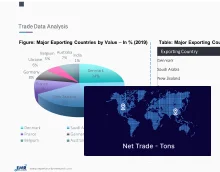
Get insights & trends for a competitive edge.
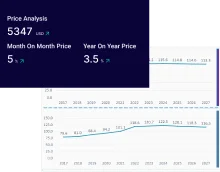
Track prices with detailed trend reports.
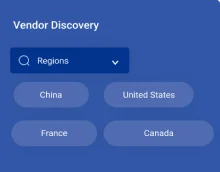
Analyse trade data for supply chain insights.
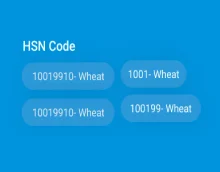
Leverage cost reports for smart savings
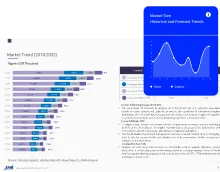
Enhance supply chain with partnerships.
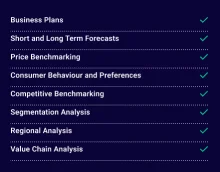
Connect For More Information
Our expert team of analysts will offer full support and resolve any queries regarding the report, before and after the purchase.
Our expert team of analysts will offer full support and resolve any queries regarding the report, before and after the purchase.
We employ meticulous research methods, blending advanced analytics and expert insights to deliver accurate, actionable industry intelligence, staying ahead of competitors.
Our skilled analysts offer unparalleled competitive advantage with detailed insights on current and emerging markets, ensuring your strategic edge.
We offer an in-depth yet simplified presentation of industry insights and analysis to meet your specific requirements effectively.



Australia
63 Fiona Drive, Tamworth, NSW
+61-448-061-727
India
C130 Sector 2 Noida, Uttar Pradesh 201301
+91-723-689-1189
Philippines
40th Floor, PBCom Tower, 6795 Ayala Avenue Cor V.A Rufino St. Makati City,1226.
+63-287-899-028, +63-967-048-3306
United Kingdom
6 Gardner Place, Becketts Close, Feltham TW14 0BX, Greater London
+44-753-713-2163
United States
30 North Gould Street, Sheridan, WY 82801
+1-415-325-5166
Vietnam
193/26/4 St.no.6, Ward Binh Hung Hoa, Binh Tan District, Ho Chi Minh City
+84-865-399-124
United States (Head Office)
30 North Gould Street, Sheridan, WY 82801
+1-415-325-5166
Australia
63 Fiona Drive, Tamworth, NSW
+61-448-061-727
India
C130 Sector 2 Noida, Uttar Pradesh 201301
+91-723-689-1189
Philippines
40th Floor, PBCom Tower, 6795 Ayala Avenue Cor V.A Rufino St. Makati City, 1226.
+63-287-899-028, +63-967-048-3306
United Kingdom
6 Gardner Place, Becketts Close, Feltham TW14 0BX, Greater London
+44-753-713-2163
Vietnam
193/26/4 St.no.6, Ward Binh Hung Hoa, Binh Tan District, Ho Chi Minh City
+84-865-399-124
Share